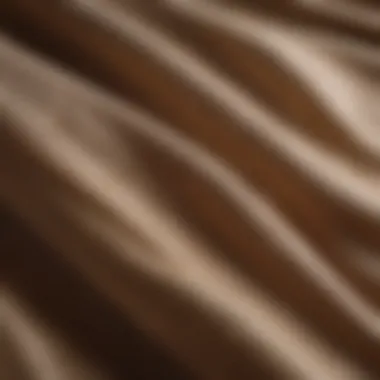Effective Methods for Removing Oil Stains


Intro
Oil stains can be a persistent nuisance, presenting a unique challenge for homeowners and fabric enthusiasts alike. Whether you spill cooking oil while preparing a meal or accidentally smudge some grease during a car maintenance session, these stains can seem nearly impossible to eliminate without damaging the fabric.
Understanding the methods available to tackle these stains is not just beneficial; it's essential for maintaining the aesthetic appeal and longevity of various garments. With a blend of household remedies and specialized commercial products at your disposal, you can effectively restore your clothing to its original condition. This guide will delve into the approaches you can utilize, as well as preventative measures to avoid such stains in the future.
By equipping yourself with the skills and knowledge to combat oil stains, you can preserve the integrity of your clothing and ensure they remain looking fresh and wearable. Here, we will explore effective techniques, assessing both traditional and modern solutions for various types of fabric.
Let’s begin by examining potential design inspirations when choosing fabrics that might be used in your creative projects or daily wear.
Foreword to Oil Stains
Oil stains on clothing are more than just a nuisance. They can ruin a favorite garment and present challenges that require attention and knowledge. Understanding how to remove these stains effectively is vital for anyone who values their wardrobe. Oil is inherently greasy and typically clings to fabric fibers, making it difficult to eliminate without the right approach.
In this article, we will explore techniques and products that can help restore clothing marred by such stains. With appropriate understanding, homeowners, party hosts, and anyone interested in fabric care can maintain their garments and prolong their lifespan. Having the right knowledge can save time and money while restoring aesthetics to your clothing.
Understanding Oil Stains
Oil stains result from various sources and can be particularly problematic. Cooking oils, motor oils, and cosmetic products are all common culprits. Each type of oil behaves differently when applied to fabric. Cooking oils might soak in, while motor oil often leaves a stubborn residue. Recognizing the origin of the stain can guide the treatment method.
The chemical structure of oils makes them insoluble in water, which complicates removal efforts. This resistance suggests that typical laundry methods may not suffice. Special treatments and methods are often necessary. Understanding the nature of these stains is the first step in successfully managing them and ensuring the longevity of fabrics.
The Impact on Fabrics
Oil stains can damage fabrics if not treated promptly and correctly. They can weaken fibers over time, leading to discoloration and deterioration. Different fabrics react variably to oil. For example, synthetic materials might be more susceptible to discoloration than cotton or linen. Additionally, delicate materials may absorb oil more easily, worsening the damage.
A timely response to these stains can mean the difference between successful removal and permanent damage. Recognizing the potential impact of oil stains on clothing helps in making informed decisions about care and treatment. This knowledge is crucial whether handling day-to-day wear or maintaining specific outfits for special occasions.
Common Sources of Oil Stains
Understanding the common sources of oil stains is essential for effective stain management. Knowing where these stains typically originate can help individuals take preventive measures, as well as respond appropriately when spills occur. Oil stains are notorious for their persistence, making it crucial to act with knowledge and preparation. The common sources range from everyday cooking activities to the maintenance of vehicles, and even to beauty routines. By recognizing these sources, one can better protect clothing and fabrics from unsightly marks, ultimately extending garment life and maintaining appearance.
Cooking Oils and Greases
One of the most frequent offenders regarding oil stains is cooking oil. When preparing meals, splatters of olive oil, canola oil, or frying grease can easily make their way onto clothing. The oils present in these substances are not only difficult to remove, but they also tend to absorb into the fabric fibers, worsening the stain.
Being aware of cooking practices can minimize the risk of stains. For instance, wearing an apron while cooking can shield garments from splatters. Additionally, handling food with care reduces accidental spills. If a stain occurs, it is important to attend to it promptly. Blotting the area immediately with a paper towel can help absorb excess oil before it sets into the fabric.
Motor Oil and Other Oils
Motor oil is another significant source of staining. Those who engage in vehicle maintenance, such as oil changes, are likely to encounter stains from this thick, dark substance. Motor oil can easily transfer from hands to clothing, or it can drip onto garments without warning.
The challenge with motor oil lies not just in its thickness, but also in its composition, which contains additives that make it particularly stubborn against removal methods. Caution is key while working on vehicle maintenance. Using gloves and ensuring that clothing is appropriate for the task can prevent many stains from occurring in the first place.
Cosmetic Products
Cosmetic products represent a less obvious but equally impactful source of oil stains. Products such as foundation, moisturizer, or even hair oils can leave behind unsightly marks on clothing. The oil-based nature of many cosmetics means that they can be quite difficult to clean.


To prevent cosmetic stains, it can be useful to apply these products cautiously while dressed in clothing one cares about. In cases where stains occur, one should quickly address them, as delaying action can make removal more challenging. Gentle dabbing and careful cleaning can mitigate damage and retain the quality of one's garments.
Recognizing common sources of oil stains enables individuals to take proactive steps. Quick action can make all the difference in preserving the integrity of clothing.
Immediate Actions After an Oil Spill
Addressing oil stains promptly can make a substantial difference in the likelihood of successful removal. Time is of the essence. Leaving an oil stain untreated increases the risk of it becoming a permanent mark on the fabric. Immediate action minimizes absorption, which is crucial, particularly for delicate materials. Knowing the right response can save both your garments and your wallet.
Act Quickly to Blot the Stain
When an oil spill occurs, your first response should be to blot the stain quickly. Blotting is important for two primary reasons: it prevents the oil from spreading and reduces the amount that penetrates the fibers. Using a clean cloth or paper towel, gently dab the affected area. Avoid pressing too hard, as this action may drive the oil deeper into the fabric.
Things to keep in mind when blotting:
- Use a clean, dry material to absorb as much oil as possible.
- Do not rub; rubbing can harm the fibers of the fabric.
- Blot from the outside of the stain inward to prevent spreading.
Remember that the aim is to lift the oil off the surface without making the situation worse. Acting fast here can radically alter the outcome of your effort.
Avoid Rubbing the Stain
Once you begin treating the stain, it is essential to refrain from rubbing. While it may seem intuitive to scrub the stain to make it disappear, this action is counterproductive. Rubbing can lead to the following issues:
- It spreads the stain to neighboring areas.
- It can embed the oil deeper into fabric fibers, making it harder to remove.
- It risks damaging more delicate fabrics and altering their appearance.
Instead of rubbing, stick with methods that promote absorption, like blotting and applying absorbent powders over the stain. This way, you protect the integrity of the fabric while also improving the odds of removing the stain altogether.
Household Remedies for Oil Stains
Household remedies for oil stains are of great significance within the context of garment care. These treatments are often readily available, cost-effective, and can deliver impressive results. Utilizing common kitchen ingredients, homeowners can address oil stains promptly, saving valuable time and potentially extending the life of beloved clothing. Beyond just immediate stain removal, household remedies often have minimal environmental impact, allowing homeowners to consider sustainability in their cleaning habits.
When dealing with oil stains, it's crucial to understand the nature of oil as a substance. Oil can bond with fabric, making it stubborn and difficult to remove. Yet, the following household items can help to loosen this bond and restore clothing to its original state.
Baking Soda
Baking soda is a versatile remedy for oil stains. Its absorbent properties make it effective for soaking up excess oils from the fabric. To utilize baking soda, first, blot the stain gently with a clean cloth to remove as much oil as possible. Next, sprinkle a generous amount of baking soda directly onto the stain and allow it to sit for about 15 to 30 minutes. This time interval enables the baking soda to absorb the oil. Afterward, brush off the powder and launder the item as usual.
Dish Soap
Dish soap, particularly those designed for cutting grease, can be a powerful agent in addressing oil stains. It's particularly effective when mixed with warm water, which can help the soap penetrate the oil more efficiently. Apply a small amount of dish soap directly to the oil stain, then work it into the fabric with your fingers or a soft brush. After giving it a few minutes to work, rinse with warm water. If any stain remains, repeat the process or combine dish soap with baking soda for increased effectiveness.
Cornstarch
Cornstarch serves as another useful option for treating oil stains. Similar to baking soda, it is known for its oil-absorbing properties. To use cornstarch, sprinkle it generously over the stained area and let it sit for at least 30 minutes. This is crucial as it allows the cornstarch to work effectively on the stain. Afterward, gently brush off the cornstarch and follow up by laundering the clothing. For stubborn stains, consider using cornstarch in combination wih dish soap to enhance effectiveness.
Household remedies should be seen as the initial line of defense against oil stains. With proper techniques and commonly available items, effective removal is achievable without heavy chemicals or costly solutions.
Commercial Products for Oil Stain Removal
When it comes to effectively tackling oil stains on clothing, commercial products serve as a powerful ally. These products are specifically formulated to break down the complex structure of various oils, making stain removal efficient and reliable. Employing these products can save time and effort, appealing to busy homeowners, interior design enthusiasts, and those who frequently host gatherings. This section will discuss three key types of commercial products designed for oil stain removal: stain remover sprays, pre-treatment laundry products, and laundry detergents with enzymatic action.


Stain Remover Sprays
Stain remover sprays are a convenient option for treating oil stains. These products often come in easy-to-use aerosol or pump spray bottles, allowing users to target specific areas directly. The primary benefit of stain remover sprays is their immediate action. Most sprays penetrate the oil stain quickly, breaking it down almost instantly. This is particularly beneficial in situations where fast response is necessary, like when an unexpected spill occurs at a social gathering.
While selecting a spray, consider checking the ingredients. Many sprays utilize surfactants that lift oils from fibers effectively. However, opting for products that do not contain harsh chemicals is wise, especially if the garment is delicate. The application is generally simple—spray on the stain, let it sit for a few minutes, and then wash as per the fabric care guidelines.
Pre-treatment Laundry Products
Pre-treatment laundry products provide another effective method to combat oil stains. These products often come in liquid or gel form and are designed to be applied before the actual washing process. They work by intensifying the cleaning action on stained areas during the wash cycle.
One key advantage of pre-treatment products is their ability to target set-in stains. After applying the product, it's essential to allow it some time to work before washing, giving the formula an opportunity to break down the oil molecules further. Look for products that are compatible with different types of fabrics to avoid any potential damage.
To use pre-treatment products efficiently, follow the guidelines given on the packaging. Make sure to apply the treatment on both sides of the fabric for best results. This way, it prevents the oil from re-entering the fabric during washing.
Laundry Detergents with Enzymatic Action
Lastly, laundry detergents with enzymatic action play a crucial role in the removal of oil stains. These detergents are engineered with enzymes that specifically target organic stains, including those from oils. Their unique formulation allows for deeper cleaning, often yielding better results than standard detergents.
Using detergents that contain enzymes can be advantageous for maintaining the overall quality of the fabric. Make sure to use the recommended amount according to the load size and water type. In hard water areas, slightly increasing the detergent amount can improve stain removal efficiency.
Choosing the Right Product
When selecting any commercial product for oil stain removal, always read the labels and directions to ensure compatibility with your fabric type. Understanding the right approach can prolong the life of your clothing while efficiently addressing oil stains.
Understanding Different Fabric Types
Understanding different fabric types is crucial when dealing with oil stains. Fabrics react differently to oil-based substances, and inappropriate treatment can lead to irreversible damage. Therefore, familiarizing oneself with the characteristics of each fabric type can significantly enhance the efficacy of stain removal techniques.
Cotton
Cotton is a popular fabric choice for many garments thanks to its breathability and softness. Oil stains on cotton can be somewhat easier to treat compared to other materials.
- Absorbency: Cotton's porous nature means it can absorb oil quickly. This is a double-edged sword. While it allows for effective cleaning later, it also means prompt action is necessary to prevent deeper penetration of the stain.
- Washing: Using warm water in conjunction with a suitable detergent often works best for cotton fabrics. However, boiling water can cause shrinkage or warping, so it is important to heed care labels.
- Durability: Cotton generally withstands vigorous cleaning methods better than delicate fabrics. For oil stains, repeated washing may be necessary until the stain is removed.
Synthetic Fabrics
Synthetic fabrics like polyester, nylon, and spandex offer unique challenges for oil stain removal. These materials are less absorbent than cotton, which is beneficial but comes with other considerations.
- Colorfastness: Many synthetic fabrics are colorfast, which means their colors will not easily fade during washing. This is advantageous; however, it also means that some harsh stain removers may cause discoloration, so caution is necessary.
- Stain Resistance: Some synthetic fabrics have stain-resistant treatments, which can hinder oil absorption. This prompts a requisite initial testing phase to determine the best method for effective stain removal.
- Temperature Sensitivity: Synthetic fabrics are sensitive to high temperatures. Using water that is too hot may ruin the integrity of the fabric, leading to permanent damage.
Delicate Materials
Delicate materials such as silk, wool, and lace require a more nuanced approach to stain removal. Their fragile fibers can easily sustain damage if treated incorrectly.
- Care Instructions: Most delicate fabrics have specific care instructions. Often, dry cleaning is recommended, but minor stains can sometimes be treated at home using gentle methods.
- Gentle Cleaning Agents: Avoid harsh chemicals. Instead, opt for mild soaps or specialized stain removers designated for delicate fabrics. When tackling oil stains, dabbing with cool water may provide relief without leading to further damage.
- Test First: Always test any treatment on an inconspicuous area before full application. This will help verify that no unwanted discoloration or damage occurs.
Understanding the unique properties of cotton, synthetic fabrics, and delicate materials is vital for effective oil stain removal. Consideration for fabric type can not only enhance cleaning success but also protect the garment's longevity.
Washing and Drying Considerations
In the realm of oil stain removal, washing and drying considerations play a critical role. Each step after treating the stain can either enhance or diminish the effectiveness of previous efforts. The decisions made during washing and drying can deeply impact the fabric’s integrity, the longevity of the garment, and the overall success in removing stains effectively. Understanding the nuances of these processes is essential.


Water Temperature
Water temperature is a fundamental aspect of laundry care. It can affect how well a stain removes from the fabric. Generally, warm or hot water is more effective in breaking down oil stains compared to cold water. Warm water can help dissolve oils and facilitates better penetration of detergents. However, using excessively hot water can lead to fabric damage, especially with delicate materials. For synthetic fabrics like polyester, hot water may distort their structure.
When dealing with oil stains:
- Warm Water (30-40°C): This is often suitable for most fabrics. It enables effective oil breakup without risking damage.
- Hot Water (above 40°C): Ideal for cottons or more durable fabrics, but should be avoided for anything labeled as delicate.
- Cold Water (below 30°C): Least effective for oil stains but necessary for certain fabrics.
Keep in mind that always check care labels before deciding on water temperature. This way, you not only preserve the fabric but also enhance your chances of successful stain removal.
Air Drying vs. Machine Drying
Choosing between air drying and machine drying is another important decision in the aftermath of washing. It can influence the final result in terms of both cleanliness and fabric health.
- Air Drying: This is generally gentler on fabrics. Hanging garments outside can allow for natural odor removal and helps avoid setting any remaining stain with heat. It also minimizes the risk of shrinkage and fabric damage. However, it takes longer and may expose clothing to outdoor contaminants.
- Machine Drying: While it is faster, this method can set any residual oil stains because heat creates a bond between the fabric fibers and the oils. Hence, if some remnants of stains are still present, machine drying can create a more permanent mark. If you choose to machine dry, always ensure that the item is completely clean.
Remember: Always evaluate the condition and fabric type of the garment before deciding on the drying method.
In summary, both washing temperature and drying method are vital to the success of oil stain removal. By making informed choices in these areas, one can significantly improve the likelihood of restoring clothing to its clean and appealing state.
Long-term Care and Prevention
Understanding the importance of long-term care and prevention of oil stains on clothing is crucial for anyone looking to maintain their wardrobe. Oil stains can weaken fabric fibers over time, leading to a dull appearance and reduced longevity of garments. Being proactive can save time and money, as well as ensuring that your clothes remain in good condition. The following aspects deserve attention for effective management of oil stains:
- Consistent Cleaning Routine: Adopting a systematic approach to laundry will help in the early detection of stains. Regularly inspect garments for any signs of grease or oil from cooking or daily activities. This not only resolves small stains before they set but also contributes to the overall cleanliness of your wardrobe.
- Prompt Attention to Spills: Even with a strong maintenance plan, spills may happen. Having a quick response strategy is key. Whenever a stain appears, treat it immediately to prevent it from becoming permanent. This means keeping some basic stain removal products on hand.
- Education on Fabric Care: Different fabrics have unique requirements. Knowing how to clean and care for materials like cotton, polyester, or silks prevents mishaps. For instance, cotton can often withstand harsher treatments, while silk requires gentler approaches.
"Being knowledgeable about fabric care is as essential as understanding your wardrobe's aesthetic appeal."
Maintaining your clothing is an ongoing process that goes beyond mere washing. It involves understanding the fabric, identifying potential sources of stains, and being prepared to act.
Regular Maintenance of Clothing
Regular maintenance plays a vital role in preventing oil stains on clothing. This maintenance step involves not just cleaning but also inspection and care of garments. Consider the following practices:
- Regular Washing: Establish a schedule that works for your lifestyle. Frequent washing of clothes helps remove residues before they turn into stubborn stains.
- Inspect Before Washing: Look over each item before it goes into the wash. This quick check can identify potential stains so you can treat them appropriately.
- Rotate Clothing: Wearing the same items repeatedly can lead to wear and stains. Rotating through your favorite pieces allows each item to rest and reduces the chance of accumulation of oils.
- Proper Storage: Store your clothes in a cool, dry place, using hangers and garment bags if necessary. Avoid cramped spaces where fabric can rub against itself and create friction that may lead to wear and potential staining.
Stain-resistant Treatments
Applying stain-resistant treatments is an effective strategy for oil stain prevention. These treatments can make a significant difference in how clothing responds to spills. Consider these points regarding stain-resistant treatments:
- Chemical Treatments: Products like Scotchgard can help repel oil and grease. Apply them to clean, dry fabric following the manufacturer’s instructions for optimal effect.
- Service Treatments: Some dry cleaners offer stain-resistant treatments during the cleaning process. This option can be especially useful for delicate or higher-end fabrics.
- DIY Alternatives: For those looking for more natural solutions, consider using beeswax or a similar wax-based spray. These treatments may not be as durable as chemical options but can offer some level of protection without harsh substances.
Taking steps for long-term care and prevention ultimately preserves both the wearability and appearance of clothing. Through regular maintenance, educational efforts, and implementing protective treatments, one can mitigate the impact of oil stains effectively. This integrated approach helps ensure that garments retain their beauty and integrity over time.
Closure
Summarizing the Importance of Prompt Action
Taking quick action against an oil stain can significantly improve the chances of successfully removing it. When a spill happens, the immediate thought should be to blot rather than rub, preserving the integrity of the fabric. By acting swiftly and using the right techniques, you can reduce the stain's ability to set in. For example, treating a grease stain with cornstarch right away sometimes lifts the stain before it has a chance to penetrate the fibers.
Furthermore, understanding what fabrics you are dealing with plays a key role in how you approach the cleaning process. Some methods may be too harsh for delicate fabrics, resulting in further damage. Thus, knowing your material alongside prompt action creates a more effective method for stain removal.
Encouragement for Continued Learning
Oil stain removal is a useful skill that can greatly benefit anyone who works with fabrics or regularly engages in tasks around the home. Continued learning about fabric care and stain management can enhance your ability to maintain your garments. Resources like books, online articles, or even community forums can provide deeper insights into additional stain removal techniques and preventive practices.















